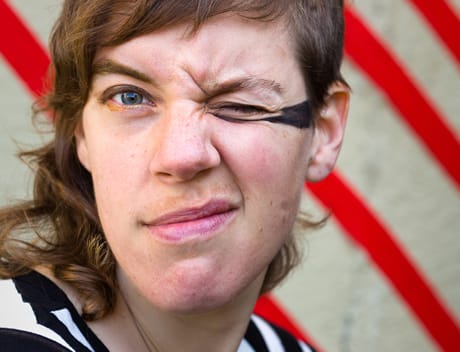Sing it loud, Merrill Garbus aka tUnE-yArDs, is back and bolder than ever with her new album Whokill. "We [she and partner Nate Brenner] had performed live so much more than before the last album," she says. "The last album was me playing at open mics and coffee shops and I think that was reflected in the intimacy of the recording." Touring with the likes of Dirty Projectors meant bigger venues and a more expansive approach by which to animate them.
Whokill overflows with fierce, exuberant rhythms and cascading horns reminiscent of Afro-experimentalists NOMO and the Souljazz Orchestra. But Garbus's vocals eschew the lame pidginisms of so many Afrobeat hybrids. Throughout the record, she sounds confident, savage, whispery, kooky or dead sexy, sometimes all at the same time. Again, physical space played a key role. "When I recorded vocals for 'Fiya' and 'Hatari' I recorded them on a dictophone in my little Chevy. That was as big as it got. I literally couldn't make too much noise."
Whokill isn't a complete reinvention. In hindsight, her first album BiRd-BrAiNs reveals traces of Garbus's African travels and expertise with live looping. Whokill amplifies the African connections "thanks to a community of musicians out here" she says, referring to her move from Montreal to Oakland. "All of the sudden I had these horn players who were excited to work with me. I realized that where I knew saxophone from the most besides jazz is from Fela. It seemed like the thing to do."
Live, tUnE-yArDs have gotten bigger in order to push this new sound across. Both horn players are touring with her, and the first stretch of dates employs soundman Eli Crews, which will no doubt facilitate the other new wrinkle to her music: dub. "Spring is here in California, and it's time for me to listen to more Lee Perry right now!"
Whokill overflows with fierce, exuberant rhythms and cascading horns reminiscent of Afro-experimentalists NOMO and the Souljazz Orchestra. But Garbus's vocals eschew the lame pidginisms of so many Afrobeat hybrids. Throughout the record, she sounds confident, savage, whispery, kooky or dead sexy, sometimes all at the same time. Again, physical space played a key role. "When I recorded vocals for 'Fiya' and 'Hatari' I recorded them on a dictophone in my little Chevy. That was as big as it got. I literally couldn't make too much noise."
Whokill isn't a complete reinvention. In hindsight, her first album BiRd-BrAiNs reveals traces of Garbus's African travels and expertise with live looping. Whokill amplifies the African connections "thanks to a community of musicians out here" she says, referring to her move from Montreal to Oakland. "All of the sudden I had these horn players who were excited to work with me. I realized that where I knew saxophone from the most besides jazz is from Fela. It seemed like the thing to do."
Live, tUnE-yArDs have gotten bigger in order to push this new sound across. Both horn players are touring with her, and the first stretch of dates employs soundman Eli Crews, which will no doubt facilitate the other new wrinkle to her music: dub. "Spring is here in California, and it's time for me to listen to more Lee Perry right now!"
